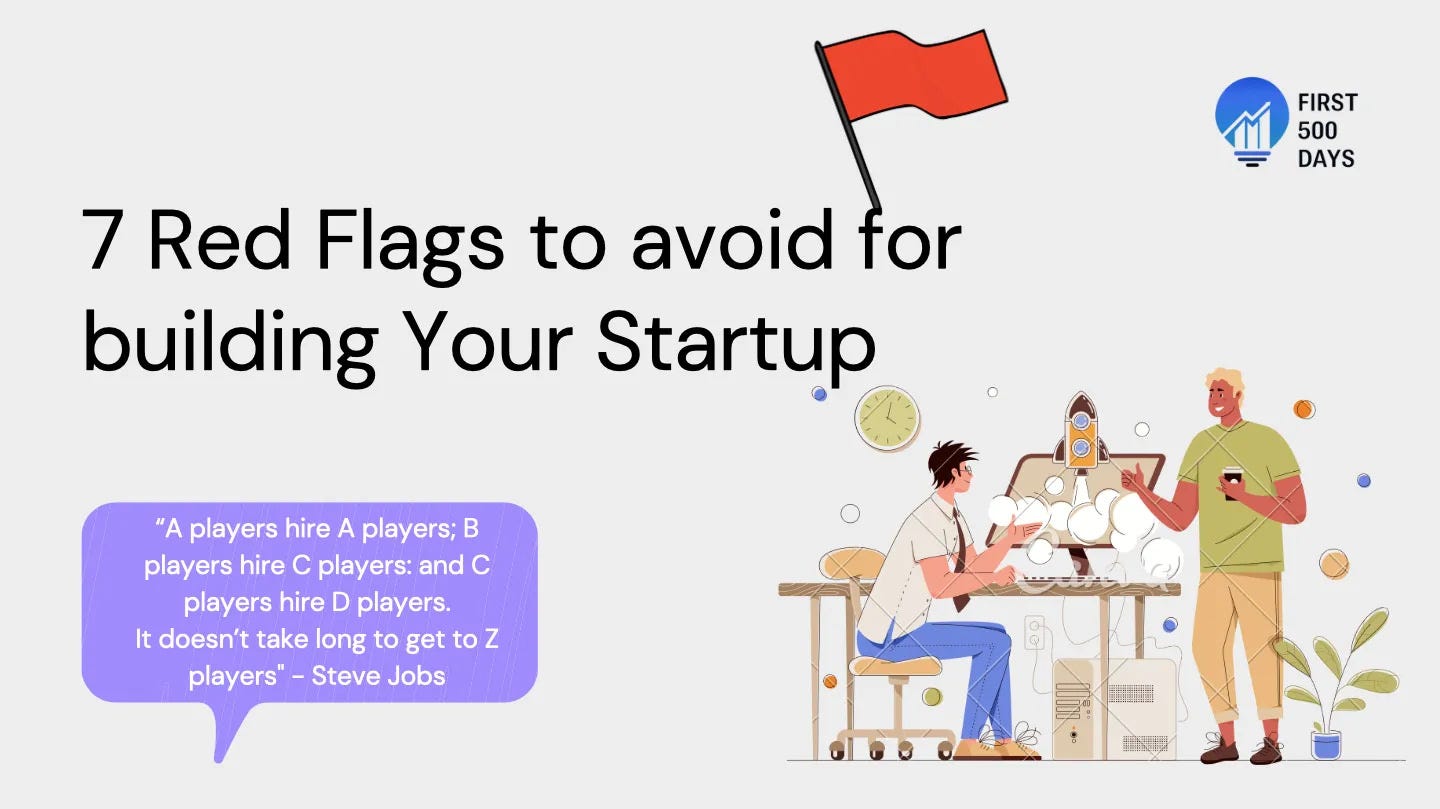Every founder starts with a belief that their idea will work, their team will deliver, and their product will stand out. But belief alone doesn’t build a successful startup; execution does.
And sometimes, the reasons startups fail aren’t dramatic. They’re small, quiet, and gradual. You don’t notice them until they’ve already done the damage.
At First500days, after working with dozens of founders across industries, we’ve seen a pattern — seven early red flags that often predict whether a startup will struggle or scale.
Here’s how to spot them before it’s too late.
1. Building Without a Real Problem
The biggest startup red flag is solving a problem that doesn’t truly exist.
Many founders fall in love with their idea, not the user’s pain. They start building features before validating whether anyone actually cares.
A successful startup begins with a genuine problem — something people are already trying to solve, even in messy, manual ways.
Ask yourself:
-
Are people actively searching for a solution?
-
Would they pay to make this pain go away?
-
Can you find 10 users today who would use your MVP for free?
If not, you’re building on assumptions — not insights.
Fix it: Validate fast. Interview users, run surveys, or launch a landing page with a signup form. Let data guide your conviction, not emotions.
2. Ignoring Early Feedback
Founders often get attached to their version of the truth. When early users give feedback that doesn’t match their vision, they either defend or ignore it.
That’s dangerous.
Feedback isn’t criticism, it’s data. It tells you where the gap lies between what you built and what users actually need.
A successful startup doesn’t chase every comment, but it listens deeply and adjusts direction accordingly.
Fix it: Create a system for structured feedback — a mix of user interviews, analytics, and small focus groups. Don’t rely on instinct alone.
3. Weak Founder Alignment
Startups don’t collapse because of product flaws; they collapse because the founders stop rowing in the same direction.
When co-founders disagree on vision, pace, or priorities, cracks appear — and those cracks widen fast.
If one founder wants to scale quickly and another prefers a slow burn, decisions turn into arguments.
And investors can sense misalignment faster than anyone.
Fix it:
Set clear roles, ownership areas, and decision protocols from day one. Have tough conversations early — about equity, commitment, and what success actually means for each person.
Remember: chemistry at the start doesn’t guarantee alignment later. Revisit expectations every few months.
4. Hiring Too Fast or Too Cheap
Hiring mistakes can quietly drain a young company.
Founders either hire too fast because they feel “busy,” or hire too cheaply because they’re saving costs. Both hurt in the long run.
Each wrong hire costs time, morale, and focus.
A successful startup doesn’t just hire people — it hires owners, not employees.
Fix it:
-
Don’t hire until there’s a clear, measurable need.
-
Prioritize generalists early — people who can wear multiple hats.
-
Pay fairly; if you can’t pay high, compensate with trust, learning, and transparency.
And most importantly — never outsource culture. Build it yourself.
5. Confusing Motion with Progress
Early-stage founders love activity. Meetings, prototypes, and brainstorming sessions — all feel like progress. But unless it moves your metrics, it’s motion without momentum.
It’s easy to get busy and forget what actually drives growth — paying users, retention, and feedback loops.
Fix it:
-
Define three key metrics for your first 500 days.
-
Review them weekly.
-
Celebrate outcomes, not activity.
A successful startup measures what matters. Everything else is noise.
6. Skipping Financial Discipline
Cash flow isn’t just a finance topic — it’s a survival skill.
Many founders focus on marketing and growth, but neglect how long their money will last.
When your expenses outgrow your revenue, panic replaces purpose.
And once panic sets in, decision-making suffers.
Fix it:
-
Maintain a 12-month financial runway visibility.
-
Track burn rate weekly.
-
Plan for the next raise before you need it.
Bootstrapped or funded, every successful startup has one thing in common — they respect their numbers.
7. Treating Marketing as an Afterthought
One of the biggest startup myths is “build it and they will come.”
They won’t.
You can’t create a successful startup in silence. Marketing isn’t optional; it’s oxygen.
And it doesn’t have to be expensive — just intentional.
Fix it:
Start marketing the day you start building. Share your journey, your learnings, and your small wins.
When people see your process, they root for your product.
Distribution is half the battle. The best ideas die unseen.
The Mindset That Prevents These Red Flags
Avoiding red flags isn’t about perfection — it’s about awareness.
Every founder will make mistakes. The difference between those who succeed and those who don’t is how quickly they correct course.
At First500days, we’ve seen startups turn around entirely by spotting just one of these red flags early — a misaligned team, a missing validation step, or a flawed growth focus.
The best founders don’t wait for clarity. They create it.
Final Thoughts
A successful startup isn’t built by doing everything right; it’s built by not repeating what’s already proven wrong.
If you can stay alert to these seven red flags —
-
Building without validation
-
Ignoring feedback
-
Weak founder alignment
-
Wrong hiring
-
Mistaking motion for progress
-
Poor financial control
-
Neglecting marketing —
You’re already ahead of most founders.
Success isn’t a straight line. It’s a series of small recoveries from near-misses.
So keep your eyes open, your team aligned, and your purpose steady, and you’ll not only build a startup that survives but one that truly succeeds.

